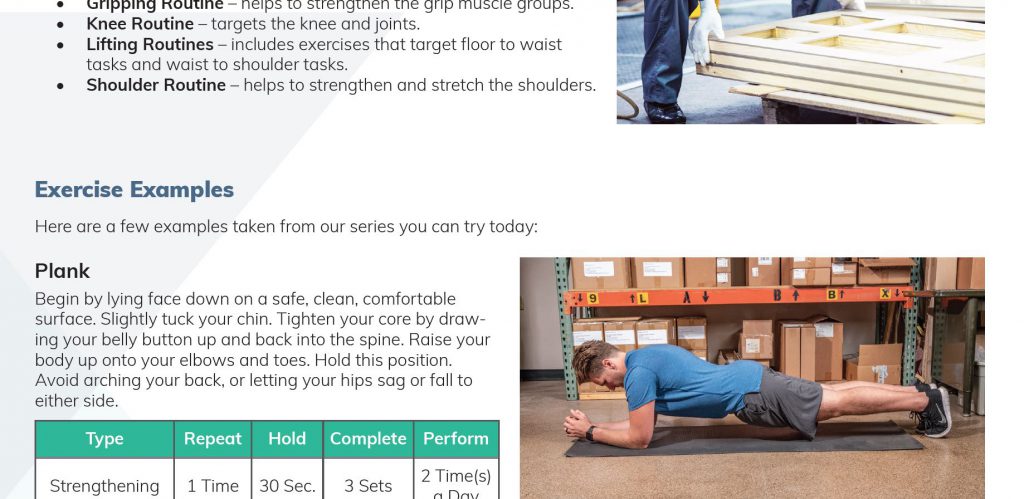The industrial workplace is often littered with complaints of musculoskeletal dysfunction, limited physical function, and painful injuries. This creates increased costs associated with process disruptions, absenteeism, turnover, direct and indirect medical costs, and so on. Workplace exercise programs are one option to overcome these obstacles.
Ergoweb believes it’s best to address the root cause of an ergonomics problem, and The Hierarchy of Ergonomic Controls provides a tried and true guide to reducing workplace hazards. If you can eliminate, substitute or engineer a fix at the root cause, you’re confident that improvement will be effective and sustainable.
But, sometimes fixing the root cause is challenging, and even when you identify that cause, a fix may not be feasible, or it’ll take time to implement.
So, we look to administrative control options like job rotation, work practice modifications, and workplace stretching and exercise programs. Administrative controls should not be your only, or even primary ergonomics hazard control option, but they may be your only short-term option.
Fortunately, controls like Workplace Exercise Programs also support your company’s wellness and behavioral safety goals.
What are Workplace Exercise Programs?
Exercise Programs aim to strengthen muscles, stabilize joints, and enhance neuromuscular patterns so that the body can operate more efficiently and safely, a common goal in ergonomics. Exercise Programs that include both stretching and strengthening have been associated with reductions in workplace injury rates.
To be considered an ergonomics administrative control, Ergoweb believes workplace Exercise Programs should be defined protocols that are tailored to the specific work tasks being performed, the population of workers performing that work, and optimally, matched specifically to individuals.
This can be done through implementing a detailed exercise routine program. A good example is Ergoweb’s exercise program, which is offered through its Ergoweb Enterprise™ software platform, where protocols are organized and matched specifically to the type of work being performed. Here’s an abbreviated example (download the complete flyer):

Download the complete example.
A one-size-fits-all exercise approach that is not tuned to the work or the workers, will not be as effective, and may even be counterproductive or contribute to injury risk.
Improve the Worker, or Improve the System?
In ergonomics, the first step is to change the system. Improvement experts like W. Edward Deming agree:
W. Edwards Demming
Eighty-five percent of the reasons for failure are deficiencies in the systems and process rather than the employee. The role of management is to change the process rather than badgering individuals to do better.
But even when changing the system, the human side must be considered. Interventions that focus on teaching the worker, like training programs, or strengthening the worker, like exercise programs, can be integral to a system’s success, provided they aren’t attempting to make a worker super-human in the face of poorly designed, inherently hazardous work.
Interventions that strictly focus on changing the worker, rather than changing the workplace, are almost guaranteed to fail.
Ergoweb Enterprise™ is a cloud-based ergonomics management software that allows companies to control their ergonomics programs and fulfill EHS regulation standards. The comprehensive system provides the necessary tools and resources to assess, quantify, and track improvement projects over time, creating a sustainable ergonomics initiative that pays for itself many times over. Request your live demonstration today.
Sources
- Cdc.gov. (2018). CDC – Hierarchy of Controls – NIOSH Workplace Safety and Health Topic. Available at: https://www.cdc.gov/niosh/topics/hierarchy/default.html [Accessed 28 Dec. 2018].
- Sultan-Taïeb, H., Parent-Lamarche, A., Gaillard, A., Stock, S., Nicolakakis, N., Hong, Q., Vezina, M., Coulibaly, Y., Vézina, N. and Berthelette, D. (2017). Economic evaluations of ergonomic interventions preventing work-related musculoskeletal disorders: a systematic review of organizational-level interventions. BMC Public Health, 17(1).
- Rodrigues, E., Gomes, A., Tanhoffer, A. and Leite, N. (2014). Effects of exercise on pain of musculoskeletal disorders: a systematic review. Acta Ortopédica Brasileira, 22(6), pp.334-338.
- Van Eerd, D., Munhall, C., Irvin, E., Rempel, D., Brewer, S., van der Beek, A., Dennerlein, J., Tullar, J., Skivington, K., Pinion, C. and Amick, B. (2015). Effectiveness of workplace interventions in the prevention of upper extremity musculoskeletal disorders and symptoms: an update of the evidence. Occupational and Environmental Medicine, 73(1), pp.62-70.
- Macmillanhighered.com. (2019). hillis2e_ch34. [online] Available at: http://www.macmillanhighered.com/BrainHoney/Resource/6716/digital_first_content/trunk/test/hillis2e/hillis2e_ch34_6.html [Accessed 2 Jan. 2019].
- Croasmun ,Jeanie, Stretching and Ergonomics, April 3, 2013, https://ergoweb.com/stretching-and-ergonomics/
